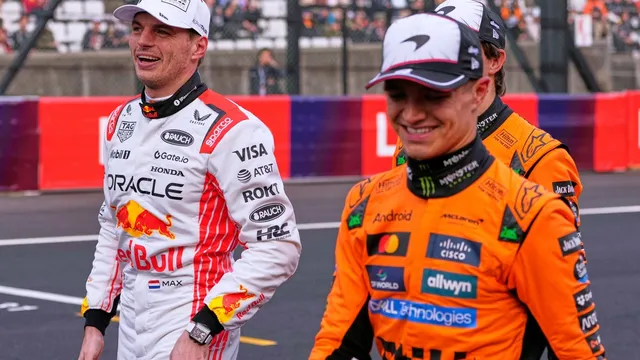
Lando Norris leads F1 championship after strong Bahrain performance
2025-04-14 10:53- Lando Norris finished third in the Bahrain Grand Prix, overcoming a five-second penalty.
- Max Verstappen of Red Bull finished sixth due to poor performance and pit stops.
- Norris leads the championship standings with 77 points, showing strong competition this season.
Express your sentiment!
Insights
In the recent Bahrain Grand Prix, held in April 2025, Lando Norris from McLaren secured a strong position in the drivers' championship. Despite a challenging qualifying round, where he faced a five-second penalty, Norris managed to finish third, showcasing his resilience. This performance resulted in him extending his lead to 77 points in the driver standings, just ahead of Oscar Piastri, who took victory with commanding ease. Meanwhile, Max Verstappen, the defending champion from Red Bull, struggled significantly throughout the race, only managing a sixth-place finish, which disappointed his team and raised concerns about their competitiveness this season. Christian Horner, the Red Bull team principal, expressed serious concerns about the team's performance following the race, stating that the issues are pressing and need immediate resolution. He acknowledged that their recent success in Japan had led them to believe they were on the right track, but Bahrain’s results revealed persistent problems that required urgent work. Horner noted that Verstappen's difficulties were compounded by poor pit stops and an overall lack of pace compared to McLaren, which has emerged as a strong contender this season. The competition has intensified, with Norris and Piastri rising as key players. Their performances have sparked debates about the strategies and performance of other teams, particularly Red Bull. Jos Verstappen, Max’s father, also weighed in on the discussion, suggesting that Red Bull should focus less on complaining about other teams' designs and instead aim to replicate their success. As the season progresses toward the next race in Saudi Arabia, the spotlight remains on whether Red Bull can bounce back from their current challenges. The ongoing rivalry between McLaren and Red Bull presents an exciting narrative for F1 fans and experts alike. The drivers themselves have commented on the challenges of the current season, with Norris noting that Verstappen's success has come in a less competitive landscape due to his teammate's struggles. With competition heating up, the team dynamics and performance of each driver will be crucial as the season heads into its next phases. The talk of potential changes, team adjustments, and strategic shifts is already beginning, foreshadowing a riveting battle ahead for the championship.
Contexts
The FIA technical regulations on front wings play a crucial role in shaping the performance and safety of modern Formula 1 cars. Front wings are essential aerodynamic components that significantly influence a car's downforce, stability, and overall handling characteristics. In recent years, the FIA has implemented stringent rules to govern various aspects of front wing design and functionality to ensure fair competition and enhance driver safety. These regulations have evolved to address technological advancements and the changing landscape of motorsport, reflecting the need for ongoing innovation while preserving the integrity of the sport. Key regulations concerning front wings include specifications related to dimensions, materials, and the permissible angles of attack. The FIA stipulates minimum and maximum widths, as well as height requirements for front wings, which help maintain a level playing field among teams. Additionally, rules are in place regarding the construction of front wings, including the types of materials that can be used. These rules aim to limit the performance advantages that could arise from the use of advanced composite materials while ensuring that wings remain robust enough to safely withstand the forces encountered during high-speed racing. The FIA also closely monitors the aerodynamic efficiency of front wings through testing and simulation protocols. The regulations require teams to submit detailed designs and modifications for approval before implementation during official events. This ensures that any innovations in front wing design do not compromise the principles of safety or competitive balance. Furthermore, the emphasis on transparency means that breakthroughs achieved by one team can be assessed and integrated into the wider framework of the competition, ultimately driving technological advancement across the sport. Overall, FIA technical regulations on front wings are foundational in maintaining a competitive yet safe environment in Formula 1. As teams continue to innovate and develop more sophisticated aerodynamic solutions, the FIA remains committed to updating these regulations to meet the evolving challenges of motorsport. This commitment reflects a balanced approach to fostering competition while ensuring the sport remains as safe and equitable as possible.